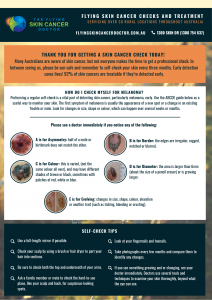We recommend that you self-check your skin at least every three months and see a professional for a skin cancer check every year. Share with your doctor any changes that you have noticed between professional checks.
Our small team is passionate about helping communities gain better access to specialist health care and skin cancer services. We work collaboratively with local doctors and health services, supporting their invaluable work in communities. Our aim is to detect skin cancer, particularly melanoma, early to save lives.
As part of our service, we will educate you about the types of skin cancer and give you a guide to conducting self-checks.

What to look for when you check your skin for skin cancer
PERFORMING A SELF SKIN CANCER CHECK
-
GET READY
Make sure you do this properly and take your time. What will you need?
- A full-length mirror or someone who can look at the back of your body
- Good lighting
- A hand mirror
- A chair
- A picture device or a notebook.
-
WHAT TO LOOK FOR
The signs of skin cancer include:
- Changes in shape, colour, size on any old spot.
- Mole or other skin marks that oozes, bleeds or becomes crusty
- A mole that is painful to the touch
- Sores that don’t heal within two weeks
- A shiny pink, red, pearly white, or translucent bump
- A mole or sore with irregular borders, which may bleed easily
Keep a record from every check by taking pictures or noting down to compare between checks the number and shape of your skin marks.
-
A SELF-CHECK STEP BY STEP
- Remove all your clothing and face the mirror to have a clear view of all your body. Proceed by areas. First, look at the front, back, and sides of your legs.
- Check new spots and the state of every mark on your skin. Look at your hands, between your fingers and under your fingernails.
- Sit down and examine your feet, checking the soles and between the toes.
- Use the hand mirror to help you. Check your scalp using a comb or a hair dryer. Then check your back.
- Then review your front side, chest, stomach and neck. Raise your arms and check your sides too. Arms and shoulders tend to be the most sun-exposed areas.
-
MELANOMA SIGNS
If you detect any new or suspicious spot, look further for Melanoma signs. Melanoma is the most serious type of skin cancer and the easiest way to discard from the risks list is by following what we call “The ABCDE guideline”. This indicates to look for:

A: is for ASYMMETRY – half of the spot or mark has a different colour than the rest.
B: is for BORDER – the edges are irregular, blurred, notched or ragged.
C: is for COLOUR – different shades of black or brown and sometimes patches of red, white or blue.
D: is for DIAMETER – the area is larger than 6mm (the size of a pencil eraser) or is growing larger.
E: is for EVOLVING – changes in shape, colour, elevation. Traits such as itching, bleeding or crusting
If any of these description matches your spot, see a doctor as soon as you can for treatment. Remember, when performed regularly, skin checks help to detect melanoma in the early stages and highly increases the chances of successful treatment. Thank yourself.



